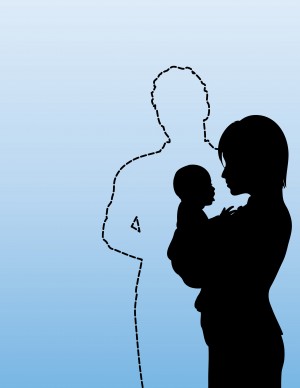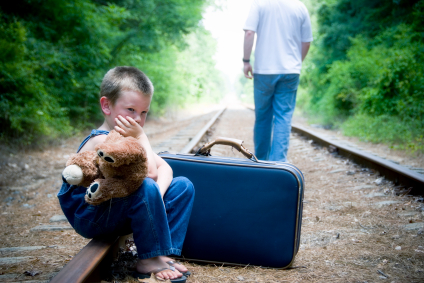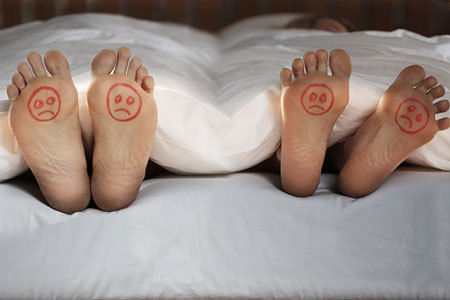Father Factor ~ Stepfather Quote and Wisdom ~ Gloria Steinem

Most American children suffer too much mother and too little father.
~ Gloria Steinem
Fathers and mothers bring different life perspectives to their children. Fathers tend to be concerned with the bottom line: numbers of hits, soccer goals, numbers of A’s and B’s on the report card, and accomplishments in general. Mothers tend to focus on socialization: manners, morals, respect, appreciation, cleanliness, thoughtfulness, etc. as well as physical and emotional health.
In a functional, (well not seriously dysfunctional), nuclear family this balance works very effectively in raising children in a balanced atmosphere but what happens when there’s no father?
One out of three children or approximately 24 million children in America live in biological father-absent homes according to U.S. Census Bureau statistics. While the United States is “the world leader in families without fathers,” the absence of fathers is a worldwide problem. Within the United States there is a “father factor” in almost every social issue facing America today.

The next two pages provides data identifying the effects of an absent father on: poverty, maternal and child health, incarceration, crime, teen pregnancy, child abuse, drug and alcohol abuse, education, and childhood obesity.
Father Factor in Poverty
- Children in father-absent homes are five times more likely to be poor. In 2002, 7.8 percent of children in married-couple families were living in poverty, compared to 38.4 percent of children in female-householder families.
- Source: U.S. Census Bureau, Children’s Living Arrangements and Characteristics: March 2002, P200-547, Table C8. Washington D.C.: GPO, 2003.
- During the year before their babies were born, 43% of unmarried mothers received welfare or food stamps, 21% received some type of housing subsidy, and 9% received another type of government transfer (unemployment insurance etc.). For women who have another child, the proportion who receive welfare or food stamps rises to 54%.
- Source: McLanahan, Sara. The Fragile Families and Child Well-being Study: Baseline National Report. Princeton, NJ: Center for Research on Child Well-being, 2003: 13.
- A child with a nonresident father is 54% more likely to be poorer than his or her father.
- Source: Sorenson, Elaine and Chava Zibman. “Getting to Know Poor Fathers Who Do Not Pay Child Support.” Social Service Review 75 (September 2001): 420-434.
- When compared by family structure, 45.9% of poor single-parent families reported material hardship compared to 38.6% of poor two parent families. For unpoor families who did not experience material hardship, 23.3% were single-parent families compared to 41.2% of two-parent families.
- Source: Beverly, Sondra G., “Material hardship in the United States: Evidence from the Survey of Income and Program Participation.” Social Work Research 25 (September 2001): 143-151.3
Father Factor in Maternal and Infant Health
- Infant mortality rates are 1.8 times higher for infants of unmarried mothers than for married mothers.
- Source: Matthews, T.J., Sally C. Curtin, and Marian F. MacDorman. Infant Mortality Statistics from the 1998 Period Linked Birth/Infant Death Data Set. National Vital Statistics Reports, Vol. 48, No. 12. Hyattsville, MD: National Center for Health Statistics, 2000.
- Unmarried mothers are less likely to obtain prenatal care and more likely to have a low birth-weight baby. Researchers find these negative effects persist even when they take into account factors, such as parental education, that often distinguish single-parent from two-parent families.
- Source: U.S. Department of Health and Human Services. Public Health Service. Center for Disease Control and Prevention. National Center for Health Statistics. Report to Congress on Out-of-Wedlock Childbearing. Hyattsville, MD (Sept. 1995): 12.
- Expectant fathers can play a powerful role as advocates of breastfeeding to their wives. Three-fourths of women whose partners attended a breastfeeding promotion class initiated breastfeeding.
- Source: Wolfberg, Adam J., et al. “Dads as breastfeeding advocates: results from a randomized controlled trial of an educational intervention.” American Journal of Obstetrics and Gynecology 191 (September 2004): 708-712.
- Fathers’ knowledge about breastfeeding increases the likelihood that a child will be breastfed. Children who fathers knew more had a 1.76 higher chance of being breastfed at the end of the first month and 1.91 higher chance of receiving maternal milk at the end of the third month.
- Source: Susin, Lurie R.O. “Does Parental Breastfeeding Knowledge Increase Breastfeeding Rates?” BIRTH 26 (September 1999): 149-155.
- Twenty-three percent of unmarried mothers in large U.S. cities reported cigarette use during their pregnancy. Seventy-one percent were on Medicare.
- Source: McLanahan, Sara. The Fragile Families and Child Well-being Study: Baseline National Report. Table 7. Princeton, NJ: Center for Research on Child Well-being, 2003: 16.
- A study of 2,921 mothers revealed that single mothers were twice as likely as married mothers to experience a bout of depression in the prior year. Single mothers also reported higher levels of stress, fewer contacts with family and friends, less involvement with church or social groups and less overall social support.
- Source: Cairney, John and Michael Boyle et al. “Stress, Social Support and Depression in Single and Married Mothers.” Social Psychiatry and Psychiatric Epidemiology 38 (August 2003): 442-449.
- In a longitudinal study of more than 10,000 families, researchers found toddlers living in stepfamilies and single-parent families were more likely to suffer a burn, have a bad fall, or be scarred from an accident compared to kids living with both of their biological parents.
- Source: O’Connor, T., L. Davies, J. Dunn, J. Golding, ALSPAC Study Team. “Differential Distribution of Children’s Accidents, Injuries and Illnesses across Family Type.” Pediatrics 106 (November 2000): e68.
- A study of 3,400 middle schoolers indicated not living with both biological parents quadruples the risk of having an affective disorder.
- Source: Cuffe, Steven P., Robert E. McKeown, Cheryl L. Addy, and Carol Z. Garrison. “Family Psychosocial Risk Factors in a Longitudinal Epidemiological Study of Adolescents.” Journal of American Academic Child Adolescent Psychiatry 44 (February 2005): 121-129.
- Children who live apart from their fathers are more likely to be diagnosed with asthma and experience an asthma-related emergency even after taking into account demographic and socioeconomic conditions. Unmarried, cohabiting parents and unmarried parents living apart are 1.76 and 2.61 times, respectively, more likely to have their child diagnosed with asthma. Marital disruption after birth is associated with a 6-fold increase in the likelihood a children will require an emergency room visit and 5-fold increase of an asthma-related emergency.
- Source: Harknett, Kristin. Children’s Elevated Risk of Asthma in Unmarried Families: Underlying Structural and Behavioral Mechanisms. Working Paper #2005-01-FF. Princeton, NJ: Center for Research on Child Well-being, 2005: 19-27.
Father Factor in Incarceration
- Even after controlling for income, youths in father-absent households still had significantly higher odds of incarceration than those in mother-father families. Youths who never had a father in the household experienced the highest odds.
- Source: Harper, Cynthia C. and Sara S. McLanahan. “Father Absence and Youth Incarceration.” Journal of Research on Adolescence 14 (September 2004): 369-397.
- A 2002 Department of Justice survey of 7,000 inmates revealed that 39% of jail inmates lived in mother-only households. Approximately forty-six percent of jail inmates in 2002 had a previously incarcerated family member. One-fifth experienced a father in prison or jail.
- Source: James, Doris J. Profile of Jail Inmates, 2002. (NCJ 201932). Bureau of Justice Statistics Special Report, Department of Justice, Office of Justice Programs, July 2004.
Father Factor in Crime
- A study of 109 juvenile offenders indicated that family structure significantly predicts delinquency.
- Source: Bush, Connee, Ronald L. Mullis, and Ann K. Mullis. “Differences in Empathy Between Offender and Nonoffender Youth.” Journal of Youth and Adolescence 29 (August 2000): 467-478.
- Adolescents, particularly boys, in single-parent families were at higher risk of status, property and person delinquencies. Moreover, students attending schools with a high proportion of children of single parents are also at risk.
- Source: Anderson, Amy L. “Individual and contextual influences on delinquency: the role of the single-parent family.” Journal of Criminal Justice 30 (November 2002): 575-587.
- A study of 13,986 women in prison showed that more than half grew up without their father. Forty-two percent grew up in a single-mother household and sixteen percent lived with neither parent. (Fathers and Daughters)
- Source: Snell, Tracy L and Danielle C. Morton. Women in Prison: Survey of Prison Inmates, 1991. Bureau of Justice Statistics Special Report. Washington, DC: US Department of Justice, 1994: 4.
- Even after controlling for community context, there is significantly more drug use among children who do not live with their mother and father.
- Source: Hoffmann, John P. “The Community Context of Family Structure and Adolescent Drug Use.” Journal of Marriage and Family 64 (May 2002): 314-330.
- Youths are more at risk of first substance use without a highly involved father. Each unit increase in father involvement is associated with 1% reduction in substance use. Living in an intact family also decreases the risk of first substance use.
- Source: Bronte-Tinkew, Jacinta, Kristin A. Moore, Randolph C. Capps, and Jonathan Zaff. “The influence of father involvement on youth risk behaviors among adolescents: A comparison of native-born and immigrant families.” Article in Press. Social Science Research December 2004.
- Of the 228 students studied, those from single-parent families reported higher rates of drinking and smoking as well as higher scores on delinquency and aggression tests when compared to boys from two-parent households.
- Source: Griffin, Kenneth W., Gilbert J. Botvin, Lawrence M. Scheier, Tracy Diaz and Nicole L. Miller. “Parenting Practices as Predictors of Substance Use, Delinquency, and Aggression Among Urban Minority Youth: Moderating Effects of Family Structure and Gender.” Psychology of Addictive Behaviors 14 (June 2000): 174-184.
- In a study of INTERPOL crime statistics of 39 countries, it was found single parenthood ratios were strongly correlated with violent crimes. This was not true 18 years ago.
- Source: Barber, Nigel. “Single Parenthood As a Predictor of Cross-National Variation in Violent Crime.” Cross-Cultural Research 38 (November 2004): 343-358.
Father Factor in Teen Pregnancy
- Being raised by a single mother raises the risk of teen pregnancy, marrying with less than a high school degree, and forming a marriage where both partners have less than a high school degree.
- Source: Teachman, Jay D. “The Childhood Living Arrangements of Children and the Characteristics of Their Marriages.” Journal of Family Issues 25 (January 2004): 86-111.
- Separation or frequent changes increase a woman’s risk of early menarche, sexual activity and pregnancy. Women whose parents separated between birth and six years old experienced twice the risk of early menstruation, more than four times the risk of early sexual intercourse, and two and a half times higher risk of early pregnancy when compared to women in intact families. The longer a woman lived with both parents, the lower her risk of early reproductive development. Women who experienced three or more changes in her family environment exhibited similar risks but were five times more likely to have an early pregnancy.
- Source: Quinlan, Robert J. “Father absence, parental care, and female reproductive development.” Evolution and Human Behavior 24 (November 2003): 376-390.
- Researchers using a pool from both the U.S. and New Zealand found strong evidence that father absence has an effect on early sexual activity and teenage pregnancy. Teens without fathers were twice as likely to be involved in early sexual activity and seven times more likely to get pregnant as an adolescent.
- Source: Ellis, Bruce J., John E. Bates, Kenneth A. Dodge, David M. Ferguson, L. John Horwood, Gregory S. Pettit, and Lianne Woodward. “Does Father Absence Place Daughters at Special Risk for Early Sexual Activity and Teenage Pregnancy.” Child Development 74 (May/June 2003): 801-821.
Father Factor in Child Abuse
- Compared to living with both parents, living in a single-parent home doubles the risk that a child will suffer physical, emotional, or educational neglect.
- Source: America’s Children: Key National Indicators of Well-Being. Table SPECIAL1. Washington, D.C.: Federal Interagency Forum on Child and Family Statistics, 1997.
- The overall rate of child abuse and neglect in single-parent households is 27.3 children per 1,000, whereas the rate of overall maltreatment in two-parent households is 15.5 per 1,000.
- Source: America’s Children: Key National Indicators of Well-Being. Table SPECIAL1. Washington, D.C.: Federal Interagency Forum on Child and Family Statistics, 1997.
- An analysis of child abuse cases in a nationally representative sample of 42 counties found that children from single-parent families are more likely to be victims of physical and sexual abuse than children who live with both biological parents. Compared to their peers living with both parents, children in single parent homes had:
- a 77% greater risk of being physically abused
- an 87% greater risk of being harmed by physical neglect
- a 165% greater risk of experiencing notable physical neglect
- a 74% greater risk of suffering from emotional neglect
- an 80% greater risk of suffering serious injury as a result of abuse
- overall, a 120% greater risk of being endangered by some type of child abuse.
- Source: Sedlak, Andrea J. and Diane D. Broadhurst. The Third National Incidence Study of Child Abuse and Neglect: Final Report. U.S. Department of Health and Human Services. National Center on Child Abuse and Neglect. Washington, D.C., September 1996.
Father Factor in Drug and Alcohol Abuse
- Researchers at Columbia University found that children living in two-parent household with a poor relationship with their father are 68% more likely to smoke, drink, or use drugs compared to all teens in two-parent households. Teens in single mother households are at a 30% higher risk than those in two-parent households.
- Source: “Survey Links Teen Drug Use, Relationship With Father.” Alcoholism & Drug Abuse Weekly 6 September 1999: 5.
- Even after controlling for community context, there is significantly more drug use among children who do not live with their mother and father.
- Source: Hoffmann, John P. “The Community Context of Family Structure and Adolescent Drug Use.” Journal of Marriage and Family 64 (May 2002): 314-330.
- In a study of 6,500 children from the ADDHEALTH database, father closeness was negatively correlated with the number of a child’s friends who smoke, drink, and smoke marijuana. Closeness was also correlated with a child’s use of alcohol, cigarettes, and hard drugs and was connected to family structure. Intact families ranked higher on father closeness than single-parent families.
- Source: National Fatherhood Initiative. “Family Structure, Father Closeness, & Drug Abuse.” Gaithersburg, MD: National Fatherhood Initiative, 2004: 20-22.
- Of the 228 students studied, those from single-parent families reported higher rates of drinking and smoking as well as higher scores on delinquency and aggression tests when compared to boys from two-parent households.
- Source: Griffin, Kenneth W., Gilbert J. Botvin, Lawrence M. Scheier, Tracy Diaz and Nicole L. Miller. “Parenting Practices as Predictors of Substance Use, Delinquency, and Aggression Among Urban Minority Youth: Moderating Effects of Family Structure and Gender.” Psychology of Addictive Behaviors 14 (June 2000): 174-184.
Father Factor in Childhood Obesity
- The National Longitudinal Survey of Youth found that obese children are more likely to live in father-absent homes than are non-obese children.
- Source: National Longitudinal Survey of Youth
- Study that looked at family lifestyle and parent’s Body Mass Index (BMI) over a nine year period found: A fathers’ body mass index (a measurement of the relative composition of fat and muscle mass in the human body) is directly related to a child’s activity level. In a study of 259 toddlers, more active children were more likely to have a father with a lower BMI than less active children.
- Father’s Body Mass Index (BMI) predicts son’s and daughter’s BMI independent of offspring’s alcohol intake, smoking, physical fitness, and father’s education
- Furthermore, BMI in sons and daughters consistently higher when fathers were overweight or obese
- Physical fitness of daughters negatively related to their father’s obesity
- Obesity of fathers associated with a four-fold increase in the risk of obesity of sons and daughters at age 18
- Source: Burke V, Beilin LJ, Dunbar D. “Family lifestyle and parental body mass index as predictors of body mass index in Australian children: a longitudinal study.” Department of Medicine, Royal Perth Hospital, University of Western Australia, and the Western Australian Heart Research Institute; Perth, Australia.
- Source: Finn, Kevin, Neil Johannsen, and Bonny Specker. “Factors associated with physical activity in preschool children.” The Journal of Pediatrics 140 (January 2002): 81-85.
A study that looked at dietary intake and physical activity of parents and their daughters over a two year period found:Study that looked at the relationship between parent’s total and percentage body fat and daughter’s total body fat over a two and one-half year period found:
- Daughter’s BMI predicted by father’s diets and father’s enjoyment of physical activity. As father’s BMI rose, so did their daughter’s BMI
- Source: Davison KK, Birch LL. “Child and parent characteristics as predictors of change in girls’ body mass index.” Department of Human Development and Family Studies, The Pennsylvania State University, University Park, Pennsylvania 16802, USA.
- Father’s, not mother’s, total and percentage body fat the best predictor of changes in daughter’s total and percentage body fat.
- Source: Figueroa-Colon R, Arani RB, Goran MI, Weinsier RL. “Paternal body fat is a longitudinal predictor of changes in body fat in premenarcheal girls.” Department of Pediatrics, General Clinical Research Center, Medical Statistics Unit, Comprehensive Cancer Center, University of Alabama at Birmingham, USA.
- Two studies that have looked at the determinants of physical activity in obese and non-obese children found: Children who lived with single mothers were significantly more likely to become obese by a 6-year follow-up, as were black children, children with nonworking parents, children with nonprofessional parents, and children whose mothers did not complete high school.
- Obese children less likely to report that their father’s were physically active than were the children of non-obese children. This determinant not found for mothers.
- Father’s inactivity strong predictor of children’s inactivity.
- Source: Trost SG, Kerr LM, Ward DS, Pate RR. “Physical activity and determinants of physical activity in obese and non-obese children. School of Human Movement Studies, The University of Queensland, Brisbane, Queensland 4072, Australia.
- Source: Fogelholm M, Nuutinen O, Pasanen M, Myohanen E, Saatela T. “Parent-child relationship of physical activity patterns and obesity.” University of Helsinki, Lahti Research and Training Centre, Finland.
- Source: Strauss RS, Knight J. “Influence of the home environment on the development of obesity in children.” Division of Pediatric Gastroenterology and Nutrition, University of Medicine and Dentistry of New Jersey, Robert Wood Johnson School of Medicine, New Brunswick, New Jersey 08903, USA.
Father Factor in Education
- Fatherless children are twice as likely to drop out of school.
- Source: U.S. Department of Health and Human Services. National Center for Health Statistics. Survey on Child Health. Washington, D.C.: GPO, 1993.
- Father involvement in schools is associated with the higher likelihood of a student getting mostly A’s. This was true for fathers in biological parent families, for stepfathers, and for fathers heading single-parent families.
- Source: Nord, Christine Winquist, and Jerry West. Fathers’ and Mothers’ Involvement in Their Children’s Schools by Family Type and Resident Status. (NCES 2001-032). Washington, D.C.: U.S. Department of Education, National Center for Education Statistics, 2001.
- Students living in father-absent homes are twice as likely to repeat a grade in school; 10 percent of children living with both parents have ever repeated a grade, compared to 20 percent of children in stepfather families and 18 percent in mother-only families.
- Source: Nord, Christine Winquist, and Jerry West. Fathers’ and Mothers’ Involvement in Their Children’s Schools by Family Type and Resident Status. (NCES 2001-032). Washington, D.C.: U.S. Department of Education, National Center for Education Statistics, 2001.
- Students in single-parent families or stepfamilies are significantly less likely than students living in intact families to have parents involved in their schools. About half of students living in single-parent families or stepfamilies have parents who are highly involved, while 62 percent of students living with both their parents have parents who are highly involved in their schools.
- Source: Nord, Christine Winquist, and Jerry West. Fathers’ and Mothers’ Involvement in Their Children’s Schools by Family Type and Resident Status. (NCES 2001-032). Washington, D.C.: U.S. Department of Education, National Center for Education Statistics, 2001.
- In 2001, 61 percent of 3- to 5-year olds living with two parents were read aloud to everyday by a family member, compared to 48% of children living in single- or no-parent families.
- Source: Federal Interagency Forum on Child and Family Statistics. America’s Children: Key National Indicators of Well-Being, 2002. Table ED1. Washington, DC: U.S. Government Printing Office, 2003.
- Kindergarteners who live with single-parents are over-represented in those lagging in health, social and emotional, and cognitive outcomes. Thirty-three percent of children who were behind in all three areas were living with single parents while only 22% were not lagging behind.
- Source: Wertheimer, Richard and Tara Croan, et al. Attending Kindergarten and Already Behind: A Statistical Portrait of Vulnerable Young Children. Child Trends Research Brief. Publication #2003-20. Washington, DC: Child Trends, 2003.
- In two-parent families, children under the age of 13 spend an average of 1.77 hours engaged in activities with their fathers and 2.35 hours doing so with their mothers on a daily basis in 1997. Children in single parent families spent on .42 hours with their fathers and 1.26 hours with their mothers on daily basis.
- Source: Lippman, Laura, et al. Indicators of Child, Family, and Community Connections. Office of the Assistant Secretary for Planning and Evaluation. Washington, DC: US Department of Health and Human Services, 2004.
- A study of 1330 children from the PSID showed that fathers who are involved on a personal level with their child schooling increases the likelihood of their child’s achievement. When fathers assume a positive role in their child’s education, students feel a positive impact.
- Source: McBride, Brent A., Sarah K. Schoppe-Sullivan, and Moon-Ho Ho. “The mediating role of fathers’ school involvement on student achievement.” Applied Developmental Psychology 26 (2005): 201-216.
- Half of all children with highly involved fathers in two-parent families reported getting mostly A’s through 12th grade, compared to 35.2% of children of nonresident father families.
- Source: National Center for Education Statistics. The Condition of Education. NCES 1999022. Washington, DC: U.S. Dept. of Education, 1999: 76.
Significance of Stepfathers
Despite the message the media would have you believe about fathers and stepfathers, there is a very important role we play in the lives of children under our care and influence. For stepfathers our role will vary from family to family dependent on the following factors:
- Moral Authority. Does our wives give us the “moral authority” to parent her children?
- Acceptance. Are you accepted by her children?
- Biological Father. What is the level of his involvement in his children’s lives?
Stepfathers will have the greatest impact in the life of children who are not blessed with the love, affection, and involvement of their biological father. To be able to reverse the negative trends reflected above biological mothers must completely support their husbands in their their parental roles. Remember they didn’t have to be. In instances where the biological father is still in the picture. There is a need to establish lines of communication for the purposes of co-parenting the children. Fathers and stepfathers are more than important in the lives of their children and stepchildren.
P.S. Please watch the following video:





